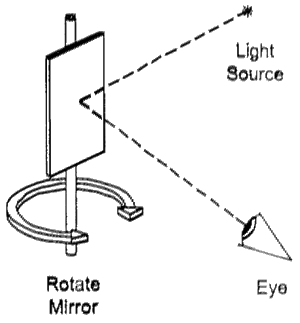The Science
Behind the
XP3 Deluxe
Message Clock
Persistence of Vision
Fascinations' new XP3™ Clock
uses "Persistence of Vision"
technology to create images floating in mid
air. We live in a world of both blinking and continuous
lights. The phenomenon known as the "persistence
of vision" causes many of the flashing
lights we see to appear continuous. This phenomenon has been
recognized for over 350 years.
Sir Isaac Newton
in Book I of his treatise on Optics wrote "When a coal of fire
moved nimbly in the circumference of a circle makes the whole
circumference appear like a circle of fire, is it not because
the motions excited in the bottom of the eye by the rays of
light are of a lasting nature, and continue till the coal of
fire in going round returns to its former place?" 1
Today, it is
understood that once light has struck the retina, all the
detection, processing, and transmission of the neural signal are
chemical. The retained image is a result mainly of the time
required for the production and decay of the photosensitive
retinal molecules. 2
The continuous
flow of retinal information received by our brain is interpreted
in discreet packets. This is because some time is required to
collect enough data for interpretation. The collection time is
referred to as the "integration time".
Amazingly, our brain is able to automatically adjust for
different light intensities. For in-stance, when less light is
available, our brain requires more time to collect sufficient
data for interpretation so it automatically selects a longer
integration time.
The XP3™ clock
offers an excellent demonstration of
the "persistence of vision".
| The XP3™
clock’s wand oscillates back and forth; in a plane that is
typically nearly perpendicular to one's line of vision,
approximately 16 times per second. Eight LEDs (light
emitting diodes) are embedded along a line near the tip of
the wand. Because the flashing LEDs remain on for only .185
milliseconds, only one point on the retina is stimulated so
our brain interprets the information as a point of light. As
the oscillating wand passes across one's field of vision,
the eight LEDs are programmed to blink, such that a pattern
is produced, which is interpreted by our brain as a
character.
Some of the LEDs need to
blink more than once in order to produce a character. For
instance, the top LED on the wand blinks five times in order
to produce the horizontal line of the top portion of the
number "3". Since up to 12 characters can be displayed at
one time, if the number '3' were repeated 12 times across
the display with no spaces between the numbers, the top LED
would flash on and off 60 times per sweep of the wand.
Amazingly, since the wand makes 16 sweeps per second, the
top LED in this example would be required to flash 960 times
per second to create the perceived pattern. Due to the
'persistence of vision', the brain does not perceive that
the points of light are being repainted 16 times per second. |
 |
|
 |
However, since
our eye's integration time is only slightly greater than the
wand's sweep time, some flickering is noticeable. One way to
reduce the flicker would be to operate the clock in a darker
location. This works because our brain, in order to gather
enough light information from the retina, automatically
shifts to a longer integration time in reduced light.
Another way to prevent flicker would be to increase the
wand's sweep rate. It is interesting to note that movie
film, which runs at only 24 frames per second, would produce
some noticeable flicker were it not for the fact that the
theater's movie projectors use a triple shutter. By
shuttering each frame three times, a flash rate of 72 times
per second is achieved. This rate is well above our brain's
integration time, thereby eliminating the flicker problem.
Computer monitors also avoid this flicker by flashing
approximately 75 times per second. |
Due to the fact
that alternating current is used to power most of the lights
around us, you might be surprised to learn how many of these
lights, which seem to be continuous, actually blink. In order to
discover which lights do blink, try the following experiment:
Attach a mirror to a small round stick. Look at the reflection
of a point light source while rotating the stick back and forth
around its major axis with the palms of your hands. If the light
source is continuous, the point of light will become a solid
line, but if it is blinking, the light will appear as a dotted
line.

References 1.
'Brewster and Wheatstone on Vision' by Nicholas Wade, Academic
Press 1983. 2. 'Molecules' by R. W. Atkins, Scientific American
Library
 SOLD
OUT!
SOLD
OUT!
Return to
the XP3 Deluxe Message Clock Product Page
|
